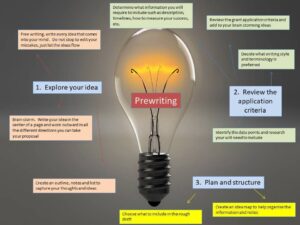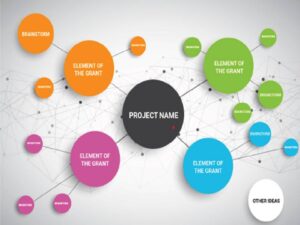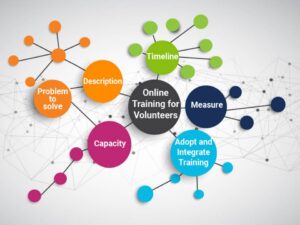You can use this process for writing grant applications, project proposals, and business cases for new projects and or programs.

Prewriting
In the prewriting stage, you will need to identify what to include in your proposal before starting the rough draft.

Creating an idea map
An idea map is a good way to create a visual representation of your brainstorming session. Here is a few steps to create an idea map for your proposal. Use this to write your first draft.
- Step 1
- Write the name of your project or program in the middle of the page and draw a circle around it
- Step 2
- Write each element of the grant around the middle circle
- Draw a circle around each element and a line connecting them back to the middle circle
- Step 3
- Start with one element
- Brainstorm everything you want to say about it
- Write everything down around the element
- Draw a circle around it
- Connect it to the grant element or to another detail
- Repeat this for the remaining grant elements
- Step 4
- In the brainstorm information that does not fit neatly into a category, write it off to the side
- When you have finished brainstorming, connect these ideas to other elements on your map

Idea Map example
You are seeking a grant to develop online training for volunteers within your community. The grant application request information including of:
- Describe the project or program you will implement using the grant funds and include a timeline
- How will this grant increase the capacity of your organisation, by introducing new online training material, working with a previously disadvantaged community, increase staff capacity to work effectively with the community?
- How will this project or program be incorporated into your organisation’s regular activities after the grant period is over?
- How will you measure the effectiveness of this project or program?

- Project Name
- Online training for Volunteers
- Description
- Describe the problem and explain how you will solve it
- Problem to solve
- Need to train and deploy volunteers faster and reduce training costs
- Solution
- Convert existing face-to-face training to online training
- Key activities
- Develop online training, including website, training material, videos, etc.
- Create exams to test knowledge
- Assign staff to review the content
- Assign staff to monitor the online training program
- Timeline
- Identify the dates for key milestones in your project timeline
- Submit call for proposals to select learning developer
- Hire learning developer
- Develop training prototype
- Review and revise content
- Train staff to make revisions
- Train staff to support online training program
- Deploy training
- Measurement
- Describe how you will measure impact
- Number of volunteers trained
- Measure volunteers’ knowledge and skills acquired through assessments
- Pilot training and obtain feedback from volunteers in the field
- Adopt and integrate training
- Explain how you will adopt and integrate the training at your organisation
- Describe promotion strategy and marketing plan (website, materials, emails)
- Identify ways to encourage staff to access online training through the LMS (learning management system)
- Train staff to make changes to the content
- Train staff to support online learners
- Capacity
- Describe what the online training will achieve for the organisation
- Reduce overall training costs by number or %
- Increase the number of volunteers trained using the same training budget
- Provide training to volunteers at any time and in any location